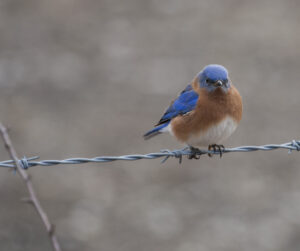Bluebirds
Bluebirds are small, vibrant songbirds that captivate birdwatchers and nature enthusiasts alike. Known for their brilliant blue feathers and cheerful songs, bluebirds belong to the thrush family and are native to North America. There are three main species: the Eastern Bluebird, Western Bluebird, and Mountain Bluebird. These beautiful creatures are often associated with happiness and symbolize hope and renewal in many cultures.

Bluebirds are easily recognizable due to their striking blue plumage and reddish-brown or white underparts, depending on the species. They are small in size, with adult bluebirds measuring around 6.5 to 8 inches long. Their wingspan typically ranges from 9.5 to 12.5 inches, and they weigh between 1.0 to 1.2 ounces, or approximately 0.06 to 0.08 lbs. Bluebirds have a soft, musical call that enhances their reputation as cheerful, peaceful birds.
Conservation efforts for bluebirds have been crucial in recent decades, as their populations faced significant declines due to habitat loss and competition with invasive species like house sparrows and European starlings. Thanks to initiatives such as the establishment of bluebird nest boxes, their numbers have rebounded in many areas. Bluebirds are now considered of least concern by conservationists, though maintaining their habitats remains essential to ensure their continued success. They thrive in open woodlands, farmlands, and suburban gardens where there are ample nesting sites and insects to feed on.
In the wild, bluebirds typically live for about 6 to 10 years, although many factors, such as predators and harsh weather, can shorten their lifespan. Bluebirds are cavity nesters, and they rely on old woodpecker holes or human-made nest boxes to rear their young. Their breeding season begins in early spring, and they often produce two to three broods each year, with both parents actively involved in raising their chicks. Bluebirds are monogamous and form strong bonds with their mates.
An adult bluebird’s diet consists primarily of insects such as beetles, grasshoppers, and caterpillars, making them an essential part of the ecosystem. During colder months, when insects are less available, bluebirds shift to eating berries and other fruits. Their diet helps control insect populations and aids in seed dispersal, contributing to the health and balance of ecosystems. This dietary versatility allows bluebirds to thrive across various environments.
Bluebirds play an important role in maintaining the balance of nature. By feeding on insects, they help control pest populations, which benefits agriculture and natural habitats. Their love for berries and fruits helps with seed dispersal, ensuring the regeneration of plant life. Bluebirds are also a symbol of environmental health, as their presence indicates well-maintained habitats and biodiversity.
In conclusion, bluebirds are more than just a beautiful sight—they are vital contributors to our ecosystems. Their vibrant colors, delightful songs, and ecological importance make them one of nature’s true treasures. Protecting bluebird populations and their habitats ensures that future generations can continue to enjoy these cheerful and hardworking birds.